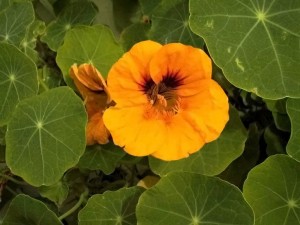 This amazing photograph,(which I would credit if I knew who shot it), looks like a fabulous carpet or maybe a contemporary abstract painting. In actuality, it’s an aerial perspective of tulip fields in Holland.
This amazing photograph,(which I would credit if I knew who shot it), looks like a fabulous carpet or maybe a contemporary abstract painting. In actuality, it’s an aerial perspective of tulip fields in Holland.
Tulips were popular at the court of Suleiman the Magnificent, Sultan of the great Ottoman Empire from 1520 to 1566, when the Ottoman empire reached from Tripoli to the Persian Gulf to Hungary. An ambassador to Austrian Emperor Ferdinand the First saw tulips in the course of his travels and brought a collection of bulbs and seeds to Vienna for his friend Carolus Clusius, Prefect of the Imperial Herb Garden. Besides nurturing the Dutch tulip industry, Clusius, born in Arras, France, where he was known as Charles De L’Ecluse, also developed the potato and chestnut.
 Parts of the tulip are edible if they haven’t been in any way involved with pesticides. During WWII, some starving Dutch ate bread made of the dried blooms ground into powder and baked. According to a report, the bread “tasted like wet sawdust.” Not very appealing.
Parts of the tulip are edible if they haven’t been in any way involved with pesticides. During WWII, some starving Dutch ate bread made of the dried blooms ground into powder and baked. According to a report, the bread “tasted like wet sawdust.” Not very appealing.
More delightful is contemplating a beautiful flower like this Flamboyant Parrot Tulip, one of the more than 3000 different kinds of registered cultivated tulips.
Tulips aren’t on the menu but nasturtiums can be. Both the leaves and flowers are edible with a peppery tang that jazzes up salads. If you have a garden, think about planting some nasturtiums this year (assuming spring and summer ever come). Nasturtiums are cheerful and have the bonus of being a great salad addition.
Nasturtium Salad (from Kit Healthcock)
1 lettuce – iceberg, butter or cos
1 small bunch of nasturtiums –both leaves and flowers (If you grow them you can be sure they haven’t been sprayed with pesticides)
2 good-sized ripe tomatoes
1 tablespoon capers
feta cheese
Wash and dry the lettuce and tear into the size pieces you prefer. Rinse the nasturtium leaves, and tear or chop into rough strips. Half small tomatoes; chop bigger ones into cubes. Cube the feta cheese and sprinkle over the salad with the capers. Top with the whole flowers and maybe one or two whole leaves. This unusual salad is is great as a side to pizza, cold meats or as a first course. If the idea of eating flowers bothers you, substitute watercress and you’ll get more or less the same taste although the salad won’t be as pretty (or get as many comments!)

